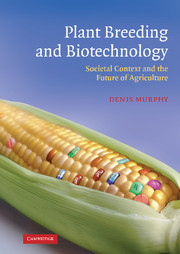Book contents
- Frontmatter
- Contents
- Preface
- Acknowledgements
- Using this book
- Nomenclature and terminology
- Abbreviations and glossary
- Introduction
- Part I The science of plant breeding
- Part II The societal context of plant breeding
- 4 Rise of the public sector and the US pioneers
- 5 Public sector breeding in the UK
- 6 Breeding goes global: the Green Revolution and beyond
- Part III Turmoil and transition: the legacy of the 1980s
- Part IV The agbiotech paradigm
- Part V Increasing global crop production: the new challenges
- Part VI Plant breeding in the twenty-first century
- Notes
- References
- Index
5 - Public sector breeding in the UK
Published online by Cambridge University Press: 07 May 2010
- Frontmatter
- Contents
- Preface
- Acknowledgements
- Using this book
- Nomenclature and terminology
- Abbreviations and glossary
- Introduction
- Part I The science of plant breeding
- Part II The societal context of plant breeding
- 4 Rise of the public sector and the US pioneers
- 5 Public sector breeding in the UK
- 6 Breeding goes global: the Green Revolution and beyond
- Part III Turmoil and transition: the legacy of the 1980s
- Part IV The agbiotech paradigm
- Part V Increasing global crop production: the new challenges
- Part VI Plant breeding in the twenty-first century
- Notes
- References
- Index
Summary
You know, this applied science is just as interesting as pure science and what's more it's a damned sight more difficult.
William Bate Hardy (1864–1934) Letter to Henry TizardIntroduction
Following the lead of the Americans in the late nineteenth century, dozens of specialised public sector agricultural research institutes were set up around the world during the early years of the twentieth century. In countries like Germany and France, state-run agricultural experimental units had been established as early as the 1850s, but these were largely desultory, uncoordinated affairs in comparison with the US Land Grant and State Agricultural Experiment Stations networks. Most of the new European agricultural research centres were relatively small and tended to specialise in local crops, often under the control of a regional administration. This meant that breeders in such centres were often less aware of scientific developments in the wider world, many of which might have had useful application to their own crops. Unlike the USA, where much of the post nineteenth century agriculture was starting with a clean slate on largely virgin land with new crops, most of the farming in Europe occurred in the context of centuries of local and regional traditions that complicated broader strategic management by the nation state.
One solution that was applied in the Netherlands was to establish a single national centre of crop innovation. This Dutch initiative occurred at about the same time the US system was finally being completed in the early twentieth century.
- Type
- Chapter
- Information
- Plant Breeding and BiotechnologySocietal Context and the Future of Agriculture, pp. 73 - 82Publisher: Cambridge University PressPrint publication year: 2007



